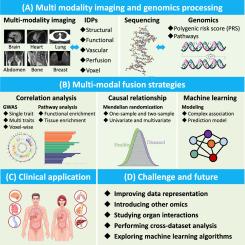数据驱动的多模态成像与基因组学融合促进精准医疗的最新进展
IF 14.7
1区 计算机科学
Q1 COMPUTER SCIENCE, ARTIFICIAL INTELLIGENCE
引用次数: 0
摘要
成像基因组学能够深入洞察疾病的遗传基础,实现早期检测,并促进个性化治疗策略,有望彻底改变临床实践。在尖端成像技术、复杂的数据驱动融合方法和广泛的大型队列数据集的推动下,该领域取得了令人瞩目的进展。成像基因组学最初以大脑为中心,现在已扩展到全身其他器官。由于成像基因组学涉及医学成像、遗传学、机器学习和临床医学等多个学科,具有高度的跨学科性质,因此希望在这一领域开展研究的读者迫切需要一本全面的综述。本研究概述了数据驱动的多模态成像与基因组学融合的最新进展,涵盖大脑、心脏、肺部、乳房、腹部和骨骼的应用。我们总结了三种主要的融合策略:相关分析、因果分析和机器学习,并讨论了它们各自的应用场景。此外,我们还探讨了在六大器官系统中整合成像数据集和基因组数据的临床应用,并介绍了以这两种模式为特色的可用开放数据集。最后,我们总结了成像基因组学面临的挑战和未来发展方向,其中包括改进数据表示、整合其他 omics 数据、进行跨数据集分析、推进机器学习算法以及研究器官相互作用。本调查旨在回顾数据驱动的精准医学融合的最新发展,同时为这一不断发展的领域的未来提供见解。本文章由计算机程序翻译,如有差异,请以英文原文为准。

Recent advances in data-driven fusion of multi-modal imaging and genomics for precision medicine
Imaging genomics is poised to revolutionize clinical practice by providing deep insights into the genetic underpinnings of disease, enabling early detection, and facilitating personalized treatment strategies. The field has seen remarkable advancements, with significant momentum fueled by cutting-edge imaging techniques, sophisticated data-driven fusion methods, and extensive large cohort datasets. Originally centered on the brain, imaging genomics has now expanded to encompass other organs throughout the body. Due to the highly interdisciplinary nature involving medical imaging, genetics, machine learning, and clinical medicine, readers who wish to conduct research in this field urgently need a comprehensive review. This survey provides an overview of recent advancements in data-driven fusion of multi-modal imaging and genomics, covering applications in the brain, heart, lungs, breasts, abdomen, and bones. We summarize three primary fusion strategies: correlation analysis, causal analysis, and machine learning, discussing their respective application scenarios. Additionally, we explore clinical applications that integrate imaging datasets and genomic data across six major organ systems, and present available open datasets featuring both modalities. Finally, we summarize the challenges and future directions in imaging genomics, which include improving data representation, integrating other omics data, conducting cross-dataset analyses, advancing machine learning algorithms, and investigating organ interactions. This survey aims to review the latest developments in data-driven fusion for precision medicine while providing insights into the future of this evolving field.
求助全文
通过发布文献求助,成功后即可免费获取论文全文。
去求助
来源期刊

Information Fusion
工程技术-计算机:理论方法
CiteScore
33.20
自引率
4.30%
发文量
161
审稿时长
7.9 months
期刊介绍:
Information Fusion serves as a central platform for showcasing advancements in multi-sensor, multi-source, multi-process information fusion, fostering collaboration among diverse disciplines driving its progress. It is the leading outlet for sharing research and development in this field, focusing on architectures, algorithms, and applications. Papers dealing with fundamental theoretical analyses as well as those demonstrating their application to real-world problems will be welcome.
 求助内容:
求助内容: 应助结果提醒方式:
应助结果提醒方式:


